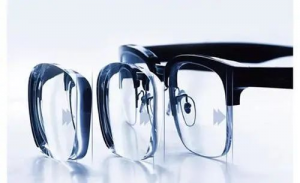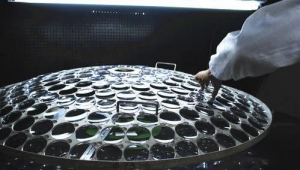Lenses are familiar to many people, and they play a major role in correcting myopia in glasses. Lenses have different coating layers, such as green coating, blue coating, blue-purple coating, and even luxury gold coating. The wear and tear of the coating layers is one of the main reasons for replacing eyeglasses, so let's learn more about the coating layers of lenses.
The development of lens coating
Before the advent of resin lenses, glass lenses were commonly used. The advantages of glass lenses are high refractive index, high light transmittance, and high hardness, but they also have disadvantages such as being prone to breakage, heavy, and unsafe.
To address the drawbacks of glass lenses, factories have developed various materials to replace glass lenses, but none are ideal. Each material has its own advantages and disadvantages, and it is difficult to achieve a balance. This also applies to current resin lenses (resin materials).
For current resin lenses, coating is a necessary process. Resin materials also have many classifications, such as MR-7, MR-8, CR-39, PC, NK-55-C, and many other resin materials, each with different characteristics. Regardless of whether it is a glass lens or a resin lens, light passing through the lens surface will undergo various optical phenomena: reflection, refraction, absorption, scattering, and transmission.
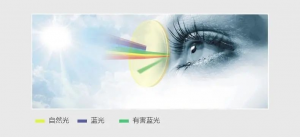
Coating the lens with an anti-reflective film
Before light reaches the surface interface of the lens, it is 100% light energy, but when it exits the lens and enters the eye, it is no longer 100% light energy. The higher the percentage of light energy, the better the light transmission, and the higher the imaging quality and resolution.
For a specific lens material, reducing reflection loss is a common method to increase light transmission. The more reflected light, the lower the transmittance of the lens, resulting in poor imaging quality. Therefore, reducing reflection has become a problem that resin lenses must solve, and anti-reflective film (AR film) has been applied to the lens (initially, anti-reflective coatings were used on some optical lenses).
Anti-reflective film utilizes the interference principle to derive the relationship between the light intensity reflectance of the coated lens anti-reflective film layer and the wavelength of the incident light, the thickness of the film layer, the refractive index of the film layer, and the refractive index of the lens substrate, allowing the light passing through the film layer to cancel each other out, reducing the loss of light energy on the lens surface and improving imaging quality and resolution.
Anti-reflective coatings often use high-purity metal oxides such as titanium dioxide and cobalt oxide, which are deposited on the lens surface through an evaporation process (vacuum deposition) to achieve good anti-reflective effects. Anti-reflective coatings often leave residues, and most film layers are predominantly in the green color range.
The color of the anti-reflective film can be controlled, for example, to produce blue film, blue-violet film, violet film, gray film, and so on. Different colored film layers have differences in the manufacturing process. For example, the blue film means that a lower reflectance needs to be controlled, and the difficulty of coating is greater than that of the green film. However, the difference in light transmission between blue and green films may be less than 1%.
In lens products, blue films are generally more common in mid to high-end lenses. In principle, the light transmission of blue films is higher than that of green films (note that this is in principle) because light is a mixture of different wavelengths, and different wavelengths have different imaging positions on the retina. Under normal circumstances, yellow-green light is precisely imaged on the retina, and the visual information contributed by green light is relatively high, so the human eye is sensitive to green light.
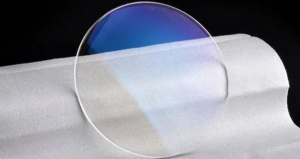
Coating the lens with a hard film
In addition to light transmission, both resin and glass materials have a significant drawback: the lenses are not hard enough.
The solution is to solve this by adding a hard film coating.
The surface hardness of glass lenses is very high (generally leaving minimal traces when scratched by ordinary objects), but this is not the case for resin lenses. Resin lenses are easily scratched by hard objects, indicating that they are not wear-resistant.
To improve the lens's wear resistance, it is necessary to add a hard film coating to the lens surface. Hard film coatings often use silicon atoms for hardening treatment, using a hardening solution containing an organic matrix and inorganic ultrafine particles including silicon elements. The hard film simultaneously possesses toughness and hardness (the film layer on the lens surface is hard, and the lens substrate is less brittle, unlike glass which is easily broken).
The main modern technology for hard film coating is immersion. The hard film coating is relatively thick, about 3-5μm. For resin lenses with hard film coatings, they can be identified by the sound of tapping on a desktop and the brightness of the lens color. Lenses that produce a clear sound and have bright edges have undergone hardening treatment.
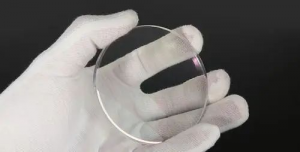
Coating the lens with an anti-fouling film.
Anti-reflective film and hard film are the two basic coatings for resin lenses at present. Generally, the hard film is coated first, followed by the anti-reflective film. Due to the current limitations of anti-reflective film materials, there is a contradiction between anti-reflective and anti-fouling capabilities. Because the anti-reflective film is in a porous state, it is particularly prone to forming stains on the lens surface.
The solution is to add an additional layer of anti-fouling film on top of the anti-reflective film. The anti-fouling film is mainly composed of fluorides, which can cover the porous anti-reflective film layer, reduce the contact area between water, oil, and the lens, while not altering the optical performance of the anti-reflective film.
With the increasing diversification of demands, more and more functional film layers have been developed, such as polarizing film, anti-static film, blue light protection film, anti-fog film, and other functional film layers. The same lens material, the same lens refractive index, different brands, and even within the same brand, with the same material, different series of lenses have price differences, and the lens coatings are one of the reasons. There are differences in the technology and quality of the coatings.
For most types of film coatings, it's difficult for the average person to discern the differences. However, there's one type of coating where the effects can be easily observed: blue light blocking lenses (a technology commonly used in high-end blue light blocking lenses).
An ideal blue light blocking lens filters out harmful blue light in the 380-460nm range through the blue light blocking film layer. However, there are differences in the actual performance among products from different manufacturers. Various products exhibit differences in blue light blocking effectiveness, base color, and light transmission, which naturally leads to varying prices.
Lens coating protection
Lens coatings are sensitive to high temperatures. The coatings on resin lenses are applied later and they all share a common weakness: they are sensitive to high temperatures. Protecting the lens coatings from bursting can effectively extend the lifespan of the lenses. The following specific environments are prone to causing damage to lens coatings:
1.Placing glasses on the dashboard of a car during midday in summer.
2.Wearing glasses or placing them nearby while using a sauna, taking a bath, or soaking in a hot spring.
3.Cooking in the kitchen at high oil temperatures; if hot oil splashes onto the lenses, they may burst immediately.
4.When eating hot pot, if hot soup splashes onto the lenses, they may burst.
5.Leaving glasses near household appliances that generate heat for a long time, such as desk lamps, televisions, etc.
In addition to the above points, it is also important to stay away from strong acidic or alkaline liquids to prevent the frames or lenses from being corroded.
The bursting of lens coatings and scratches are fundamentally different. Bursting is caused by exposure to high temperatures or chemical liquids, while scratches result from improper cleaning or external impact.
In reality, glasses are a rather delicate product. They are sensitive to pressure, falls, bending, high temperatures, and corrosive liquids.
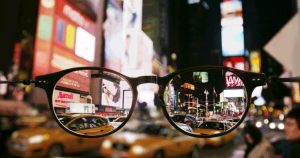
To protect the optical performance of the film layer, it is necessary to:
1.When taking off your glasses, put them in a protective case and store them in a place where children cannot reach.
2.Clean the glasses with a diluted neutral detergent using cool water. It is not recommended to use any other liquid to clean the glasses.
3.In high-temperature environments (especially during bathing or cooking), it is advisable to wear old glasses to prevent damage to the lenses of the new glasses.
Some people may rinse their glasses with warm water while washing their hair, face, or taking a shower in order to make the glasses cleaner. However, this can actually cause significant damage to the lens coatings and may render the lenses unusable. It is important to emphasize that glasses should only be cleaned with a diluted neutral detergent using cool water!
In conclusion
with the continuous advancement of coating technology, modern eyewear products have made significant progress in light transmittance, scratch resistance, and anti-fouling properties. The majority of resin lenses, PC lenses, and acrylic lenses can meet people's daily needs in terms of coating design.
As mentioned above, eyeglasses are actually quite delicate products, which is related to the coating technology of the film layer, especially the high requirements for temperature usage. Finally, I would like to remind you: once you find damage to the film layer of your eyeglass lenses, replace them immediately. Never continue using them carelessly. Damage to the film layer can alter the optical performance of the lenses. While a pair of lenses is a small matter, eye health is of utmost importance.
Post time: Dec-21-2023



